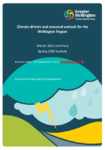Climate drivers and seasonal outlook for the Wellington Region - Winter 2022 summary and Spring 2022 outlook
Search in document library
Winter 2022 was the warmest on record for our region, and New Zealand as a whole, for the second consecutive year. On top of that, the western side of the ranges also had the wettest winter on record. Importantly, the sum of the total rainfall for summer and winter combined was the largest on record by a very substantial margin for Wellington, after the two individual seasons were also unprecedented. This compounding effect helps explain the saturation levels of the Wellington soil without time for recovery, leading to widespread slips by the end of winter. Various other records were also observed either individually or seasonally. For night-time minimum temperature, for example, virtually all stations in the region had all-time records broken for both the highest averages and the warmest individual nights. For maximum day-time temperatures the records were slightly less widespread but still of interest. Worth of note were the records for Paraparaumu of almost 20 degrees on 26 July (that’s the mid of winter!), and 22 degrees in Ngawi on 19 August. In the Wairarapa, Martinborough measured 115 km/h gusts on 13 June, which is also an all-time record, along with almost 160 km/h on 21 July for Baring Head (in that case it was a southerly blast!). Severe thunderstorms and even tornadoes also affected the region several times this winter, at times with a large thunderstorm line crossing all the way from the Kapiti coast to the Eastern Wairarapa hills (see back cover above). By all means, this was one of the most remarkable winters the region has ever recorded.
